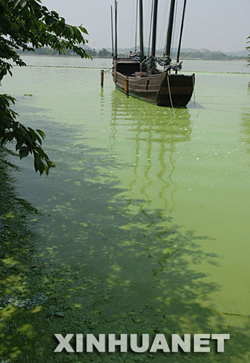High-tech from Utah helps clean Taihu Lake
|
 A file photo of Taihu Lake hit by devastating algae in May 2007. |
After Taihu Lake was hit by devastating attack of algae in 2007, patented water pollution control technologies from the United States were found to help the nation's second-largest body of fresh water, said Yang Liming, executive director of the Utah-Taihu Institute of Environmental Research (UTIER).
Located in the Yangtze Delta linking two cities in east China - Wuxi and Huzhou - the Taihu Lake complex includes more than 180 smaller lakes and rivers.
The lake suffers from an algal bloom widely believed to be caused by industrial wastewater and runoff from chemically treated agricultural land around Taihu.
In 2007, the algae attack caused a crisis in Wuxi when millions of residents lacked drinkable water, spurring the central and local governments to action.
One of the efforts was the 2009 formation of UTIER by the Wuxi city government in cooperation with the US state of Utah.
It brings together municipal officials and industrial experts to find a solution to Taihu's problems, as well as promote green technology and renewable energy.
To solve the lake system's problem of eutrophication - excessive nutrients that feed algae which in turn starve the lake of oxygen - authorities approved new biological and chemical treatment for wastewater and imported biological nutrient removal technology from Utah, Yang noted.
Utah's success in treating the Great Salt Lake offered a model for Taihu to follow, according to Wuxi authorities.
"Due to our close attention to intellectual property protection, our collaboration has been smooth," Yang said.
"Efforts to control Taihu pollution have brought preliminary results," he said. "One of our goals is to build a working model, so the project is valuable in dealing with other water pollution in China."
Statistics from the National Department of Environmental Monitoring show surface water across China was still seriously polluted in 2008, with 41 out of 200 monitored rivers nationwide registering below the Grade V mark - the lowest standard in water quality.
Wei Yanliang, assistant director at the Intellectual Property Research Center, blames the pollution on the massive wastewater discharges.
More than 100,000 water treatment patents have been registered worldwide, covering the treatment of sewage, wastewater, reclaimed water and sludge.
Chinese patents mainly relate to large equipment such as catalysts, according to the State Intellectual Property Office.
 0
0 







Go to Forum >>0 Comments